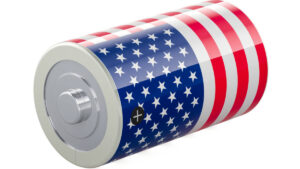Resources Top 5: A 1460g/t gold hit, more lithium, and Europe’s first battery anode factory goes live

Pic: Getty
- Siren Gold hits 2.5m at 358.2g/t
- Tempest Minerals now up an eyewatering 510% since announcing big copper discovery on Monday
- Bulletin Resources picks up lithium rock chips as high as 7.04% Li2O
- Talga’s Electric Vehicle Anode (EVA) qualification plant in Sweden is now operational
Here are the biggest resources winners in early trade, Thursday March 31.
SIREN GOLD (ASX:SNG)
Remember the visible gold hit which sent SNG flying earlier this month?

Assays have returned from the lab showing a 2.5m mineralised interval grading 358.2g/t.
That includes a 60cm chunk grading 1,460g/t gold.
The intersection, from the deepest hole ever drilled at the ‘Alexander River’ project, is comparable to drillhole intersections in the very high-grade Swan Zone at Fosterville, SNG says.
The 49g/t ‘Swan Zone’ orebody is part of the 500,000ozpa Fosterville mine; one of the richest, lowest-cost gold operations in the world.
As a point of reference, anything above 5g/t is generally considered high grade. 49g/t average across an orebody is super high grade.
SNG says this hit extends the ‘McVicar West’ gold shoot to ~500m down plunge and the shoot remains open at depth.
Over the next quarter, drilling will target McVicar West down plunge of this hit, and the ‘Bull West’ shoot below it.
It is not often that you see a 2.5m @ 11.5oz per tonne intersection in the modern era, SNG managing director Brian Rodan says.
“The Company believes this intersection provides additional credence to our long-held belief that the deeper we drill at Alexander River the more visible gold we will intersect and the same holds true for our Big River, St George, and Lyell projects,” he says.
“Siren Gold is currently progressing a significant amount of work at its Reefton gold project and with the commencement of our third rig at Big River the company certainly looks forward to exciting times ahead on our virtually untouched Reefton Goldfield tenement package.”
SNG is focused on exploring the rich Reefton gold district on the South Island of New Zealand, an area which has already delivered 2Moz across 84 historical mines.
The $36m market cap stock is up 42% year-to-date. It had $5.7m in the bank at the end of December.
TEMPEST MINERALS (ASX:TEM)
(Up on no news)
The explorer is now up an eyewatering 510% since announcing that big copper discovery on Monday.
The first 709m-long hole of a two-hole diamond drilling program at ‘Orion’ — part of the flagship ‘Meleya’ project in WA — pulled up three mineralised copper sections:
- 8m of interbedded semi-massive (pretty high grade) base metal/magnetite minerals from 18m;
- 10m of copper bearing semi-massive sulphides within a 20m disseminated sulphide zone from 422m; and
- 18m of copper bearing disseminated and stringer veins within a broader ~100m disseminated sulphide zone from 610m to end of hole.
‘To end of hole’ means the third mineralised zone probably keeps going at depth.
This is a spectacular outcome, TEM managing director Don Smith says.
“To make a new discovery on our very first hole into an entirely untested region far exceeds our expectations,” he says.
“This drilling was designed to help understand the geology and to inform future exploration and we’ve actually hit multiple zones of sulphides and copper mineralisation.
“It shows our tech innovation, science and hard work are paying off. The team and I are very excited and just itching to get on with analysing exactly what we have here, do more drilling and continue exploring the hundreds of square kilometres of untested ground along strike we have secured.”
Assays are pending. The second drillhole is in progress to depth of ~1.1km.
The ~$70m market cap stock is now up 875% year-to-date. It had $1.7m in the bank at the end of December.
BULLETIN RESOURCES (ASX:BNR)
More high-grade lithium rock chips from the ‘Ravensthorpe’ project in WA, with analysis returning results as high as 7.04% Li2O.
Hard rock lithium operations usually produce at grades of ~1% lithium.
The results come from two new areas of mineralisation, complementing known spodumene occurrences at the ‘Big’, ‘Deep Purple’ and ‘Creek’ pegmatites and “further supporting and significantly increasing the lithium prospectivity of the Eastern Pegmatite Trend”.
BNR will continue the mapping and sampling program while environmental studies required for clearing permits progress.
The 130km2 Ravensthorpe lithium Project is just 12km from Allkem’s (ASX:AKE) Mt Cattlin lithium mine.
BNR is all cashed up with $12m on hand at the end of December after selling its shareholding in Apollo Consolidated (ASX:AOP).
The $66m market cap stock is up almost 200% year-to-date.
IONEER (ASX:INR)
Despite some potentially sticky environmental issues, the North American lithium developer has continued to hit several key milestones at the ‘Rhyolite Ridge’ project (50% INR).
Earlier this week it announced an MoU today with NexTech Batteries which will acquire lithium carbonate and/or lithium hydroxide supply from Rhyolite Ridge.
NexTech will use it to manufacture its next generation solid-state lithium-sulphur batteries.
“The fact that the Rhyolite Ridge Project is located a short distance from our facility will also allow us to lower our supply chain carbon footprint, reduce dependence on foreign suppliers, and create jobs right here in Nevada,” CEO Bill Burger says.
The two parties intend to discuss the potential for long-term supply once production has commenced.
INR says the 22,000tpa lithium project is on track to be construction ready by Q4 this year.
The $1.4bn market cap stock is down 20% year-to-date.
TALGA GROUP (ASX:TLG)
TLG is spearheading the trend for graphite plays to move downstream from mining (which is low margin) towards anode production (which is high margin).
The stock says its Electric Vehicle Anode (EVA) qualification plant in Luleå, Sweden is now operational, on time and budget:

The first of its kind in Europe, EVA will produce large scale commercial samples of TLG’s coated active anode material for qualification by battery customers.
Large scale commercial testing is a critical stage in the EV customer procurement process for active anode material, the company says.
“With demand for clean graphite anode rising, Talga’s Electric Vehicle Anode plant is an important step in the journey for the establishment of a European EV and battery supply chain,” managing director Mark Thompson says.
“We look forward to start delivering large scale samples to engaged EV battery customers.”
Following the EVA anode plant, Talga will ramp up to initial 19,500tpa (~16GWh) of coated anode production from 2024.
In 2025 it aims to expand to produce more than 104,000tpa, making it one of the largest anode producers outside China.
The $500m market cap stock is flat year-to-date. It had $31.4m in the bank at the end of December.

UNLOCK INSIGHTS
Discover the untold stories of emerging ASX stocks.
Daily news and expert analysis, it's free to subscribe.
By proceeding, you confirm you understand that we handle personal information in accordance with our Privacy Policy.








